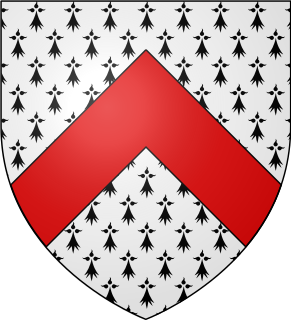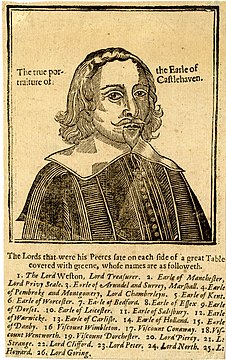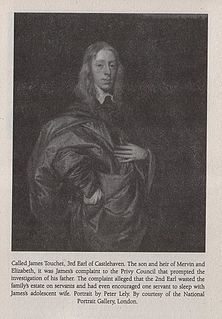
George Tuchet, 1st Earl of Castlehaven, was the son of Henry Tuchet, 10th Baron Audley and his wife, née Elizabeth Sneyd.

Mervyn Tuchet, 2nd Earl of Castlehaven, was an English nobleman who was convicted of rape and sodomy and subsequently executed. He is the only member of parliament to be executed for a non-political crime.

James Tuchet, 3rd Earl of Castlehaven was the son of Mervyn Tuchet, 2nd Earl of Castlehaven and his first wife, Elizabeth Barnham. Castlehaven played a prominent role in the Wars of the Three Kingdoms that took place in the middle of the 17th century, and was particularly active in the conflicts in Ireland at this time.
Mervyn Tuchet, 4th Earl of Castlehaven was the third son of Mervyn Tuchet, 2nd Earl of Castlehaven, and his first wife, Elizabeth Barnham.
James Tuchet, 6th Earl of Castlehaven was the son of James Tuchet, 5th Earl of Castlehaven and his wife Anne Pelson.
John Talbot Tuchet, 8th Earl of Castlehaven was the son of James Tuchet, 6th Earl of Castlehaven, and his wife, née Elizabeth Arundell. He succeeded his brother as Earl of Castlehaven and Baron Audley on 6 May 1769.

Baron Audley is a title in the Peerage of England first created in 1313, by writ to the Parliament of England, for Sir Nicholas Audley of Heighley Castle, a member of the Anglo-Norman Audley family of Staffordshire.

Earl of Airlie is a title of the peerage in Scotland created on 2 April 1639 for James Ogilvy, 7th Lord Ogilvy of Airlie, along with the title “Lord Ogilvy of Alith and Lintrathen.” The title “Lord Ogilvy of Airlie” was then created on 28 April 1491.
There have been two creations of the title Baron Offaly, both in the Peerage of Ireland.
Lord Hamilton, Baron of Strabane, in the County of Tyrone, is a title in the Peerage of Ireland created on 8 May 1617, for James Hamilton, Master of Abercorn, eldest son of James Hamilton, 1st Earl of Abercorn, during the life of his father ; the barony had the special remainder to the heir-males of his father. He was about thirteen at the time. Both Abercorn and Paisley were in the peerage of Scotland. He inherited his father's several titles in 1618, his grandfather's title in 1621.
George Thicknesse, later Thicknesse-Touchet, 19th Baron Audley was an English peer.

Lieutenant-General Charles Butler, 1st Earl of Arran, de jure3rd Duke of Ormonde (1671–1758) was an Anglo-Irish peer. His uncle Richard was the 1st Earl of Arran of the first creation. The titles were re-created for Charles in 1693. His elder brother, the 2nd Duke of Ormonde, was attainted during the Jacobite rising of 1715, but in 1721 Arran was allowed to buy the estate back. At the death of the 2nd Duke he succeeded as de jure 3rd Duke of Ormonde in the Peerage of Ireland but did not claim the title.
Baron Tuchet was a title that was twice been created in the Peerage of England.
Margaret de Audley,suo jure2nd Baroness Audley and Countess of Stafford was an English noblewoman. She was the only daughter of Hugh de Audley, 1st Earl of Gloucester, by his wife Lady Margaret de Clare. Her mother was the daughter of Joan of Acre, Princess of England; thus making Margaret a great-granddaughter of King Edward I by his first consort, Eleanor of Castile. As the only daughter and heiress of her father, she succeeded to the title of 2nd Baroness Audley [E., 1317] on 10 November 1347.

James Tuchet, 7th Baron Audley was the only lord to fully join the Cornish Rebellion of 1497 opposing the rule of Henry VII of England. He was a leader in the rebel army's march to the edge of London, and in its defeat at the Battle of Deptford Bridge. Captured on the battlefield, he was sentenced for treason and beheaded. His peerage was forfeited, but restored to his son in 1512.
Tuchet is a surname, and may refer to:
Castlehaven may refer to:
Richard Grey, 3rd Earl of Tankerville, 8th Lord of Powys fought on the side of the House of York in the War of the Roses.
Elizabeth Brudenell, Countess of Cardigan, formerly Lady Elizabeth Waldegrave, was the second wife of James Brudenell, 5th Earl of Cardigan.
Catherine Cecil, Countess of Salisbury, formerly Lady Catherine Howard, was the wife of William Cecil, 2nd Earl of Salisbury.







